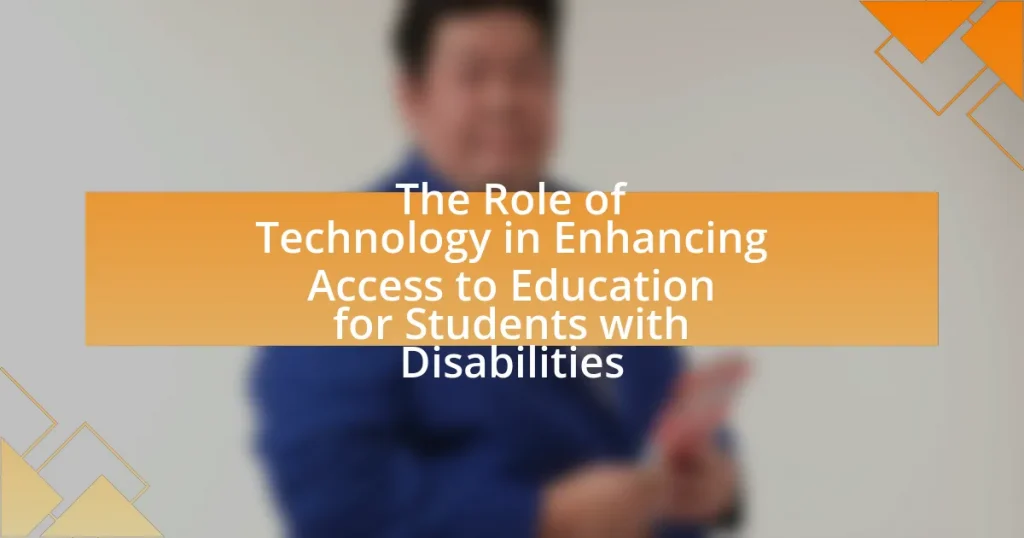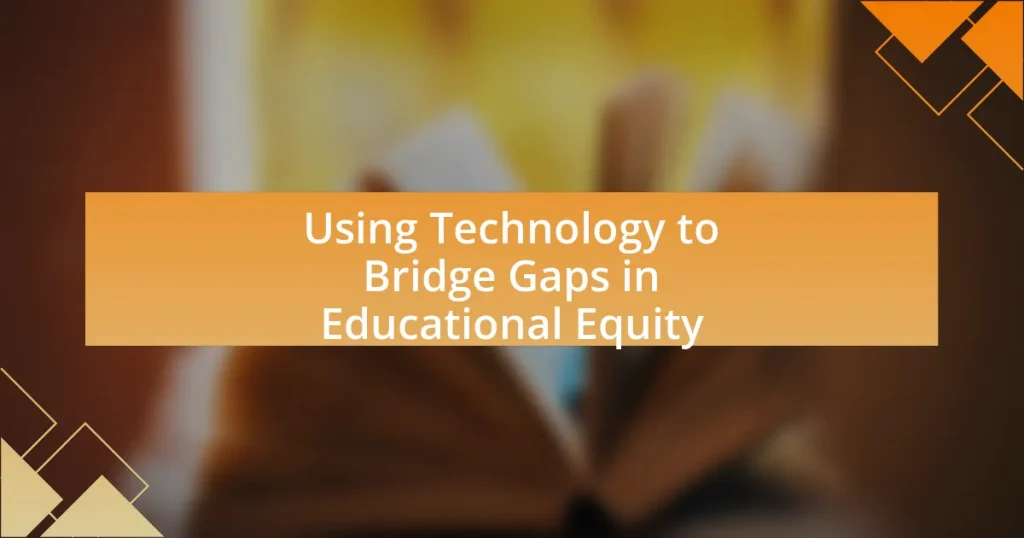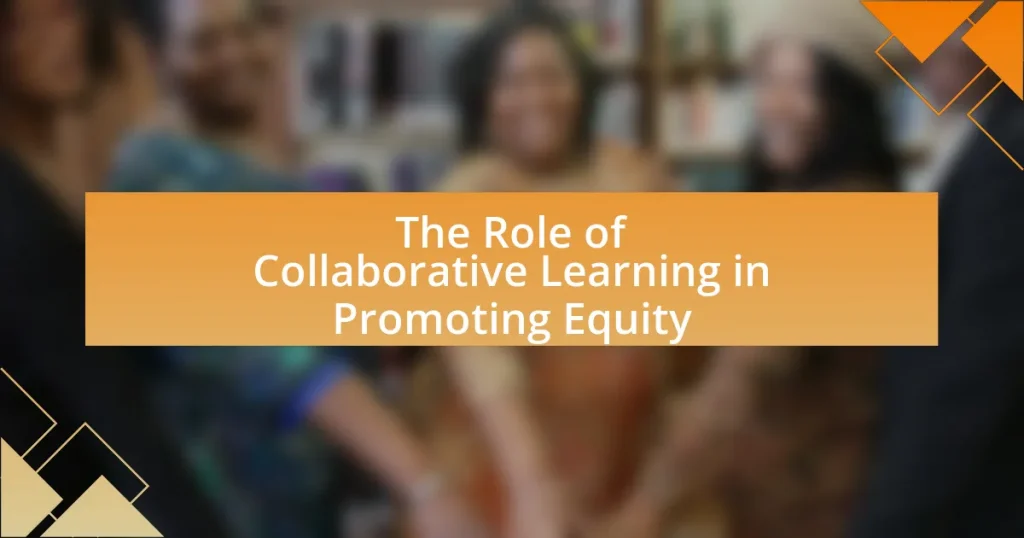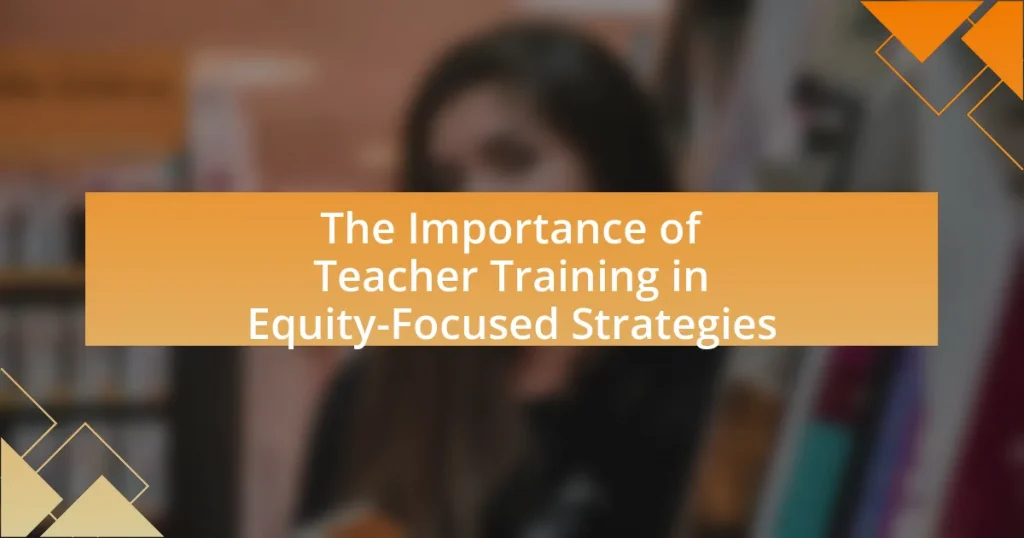The article examines the critical role of technology in enhancing educational access for students with disabilities. It highlights various assistive technologies, such as screen readers and speech-to-text software, which facilitate effective learning for students with diverse needs. The discussion includes the impact of online learning platforms and adaptive learning technologies on academic performance and engagement, as well as the importance of inclusive education. Additionally, the article addresses the barriers faced by students with disabilities in traditional educational settings and outlines best practices for educators to implement technology effectively, ensuring accessibility and support for all learners.

What is the Role of Technology in Enhancing Access to Education for Students with Disabilities?
Technology plays a crucial role in enhancing access to education for students with disabilities by providing tailored learning tools and resources that accommodate diverse needs. Assistive technologies, such as screen readers, speech-to-text software, and adaptive learning platforms, enable students with visual, auditory, or cognitive impairments to engage with educational content effectively. For instance, a study by the National Center for Learning Disabilities found that 65% of students with disabilities reported improved academic performance when using assistive technology. Additionally, online learning platforms offer flexible access to materials, allowing students to learn at their own pace and in environments that suit their individual requirements. This integration of technology not only fosters inclusivity but also empowers students with disabilities to achieve their educational goals.
How does technology facilitate learning for students with disabilities?
Technology facilitates learning for students with disabilities by providing tailored tools and resources that accommodate diverse learning needs. For instance, assistive technologies such as screen readers, speech-to-text software, and adaptive devices enable students with visual, auditory, or physical impairments to access educational content effectively. Research indicates that the use of technology in classrooms can lead to improved academic performance and engagement among students with disabilities, as evidenced by a study published in the Journal of Special Education Technology, which found that 70% of students using assistive technology showed significant gains in literacy skills. This demonstrates that technology not only enhances accessibility but also fosters an inclusive learning environment that supports the educational success of students with disabilities.
What types of technology are most effective for students with disabilities?
Assistive technology is the most effective type of technology for students with disabilities. This includes tools such as speech-to-text software, screen readers, and communication devices that facilitate learning and communication. Research indicates that the use of assistive technology can significantly improve academic performance and engagement among students with disabilities, as evidenced by a study published in the Journal of Special Education Technology, which found that 70% of students using assistive technology showed improved writing skills. Additionally, adaptive learning technologies, such as personalized learning platforms, cater to individual learning needs, further enhancing educational access and outcomes for these students.
How do assistive technologies support diverse learning needs?
Assistive technologies support diverse learning needs by providing tailored tools that enhance accessibility and engagement for students with varying abilities. These technologies, such as text-to-speech software, screen readers, and adaptive devices, enable learners to access educational content in formats that suit their individual requirements. For instance, a study published in the “Journal of Special Education Technology” found that the use of assistive technologies significantly improved reading comprehension and engagement among students with learning disabilities, demonstrating their effectiveness in addressing specific educational challenges.
Why is access to education important for students with disabilities?
Access to education is crucial for students with disabilities because it empowers them to develop essential skills, gain knowledge, and achieve independence. Education provides these students with opportunities to participate fully in society, enhancing their quality of life and enabling them to contribute to the economy. According to the National Center for Education Statistics, students with disabilities who receive appropriate educational support are more likely to graduate from high school and pursue post-secondary education, which significantly improves their employment prospects and social integration.
What are the barriers faced by students with disabilities in traditional education settings?
Students with disabilities face several barriers in traditional education settings, including physical accessibility issues, inadequate support services, and negative attitudes from peers and educators. Physical accessibility barriers often manifest in the form of inaccessible buildings, classrooms, and restrooms, which hinder mobility for students with physical disabilities. Inadequate support services, such as insufficient special education resources or lack of trained staff, limit the ability of these students to receive the necessary accommodations for their learning needs. Additionally, negative attitudes and stigma from peers and educators can create an unwelcoming environment, further isolating students with disabilities and impacting their academic performance and social integration. These barriers collectively contribute to the challenges faced by students with disabilities in accessing quality education.
How does inclusive education benefit all students?
Inclusive education benefits all students by fostering a diverse learning environment that enhances social skills and academic performance. Research indicates that when students learn alongside peers with different abilities, they develop greater empathy, collaboration, and communication skills. A study published in the Journal of Special Education found that inclusive classrooms lead to improved academic outcomes for both students with disabilities and their typically developing peers, as they engage in cooperative learning activities that promote critical thinking and problem-solving. Furthermore, inclusive education prepares all students for real-world interactions, equipping them with the skills necessary to thrive in a diverse society.
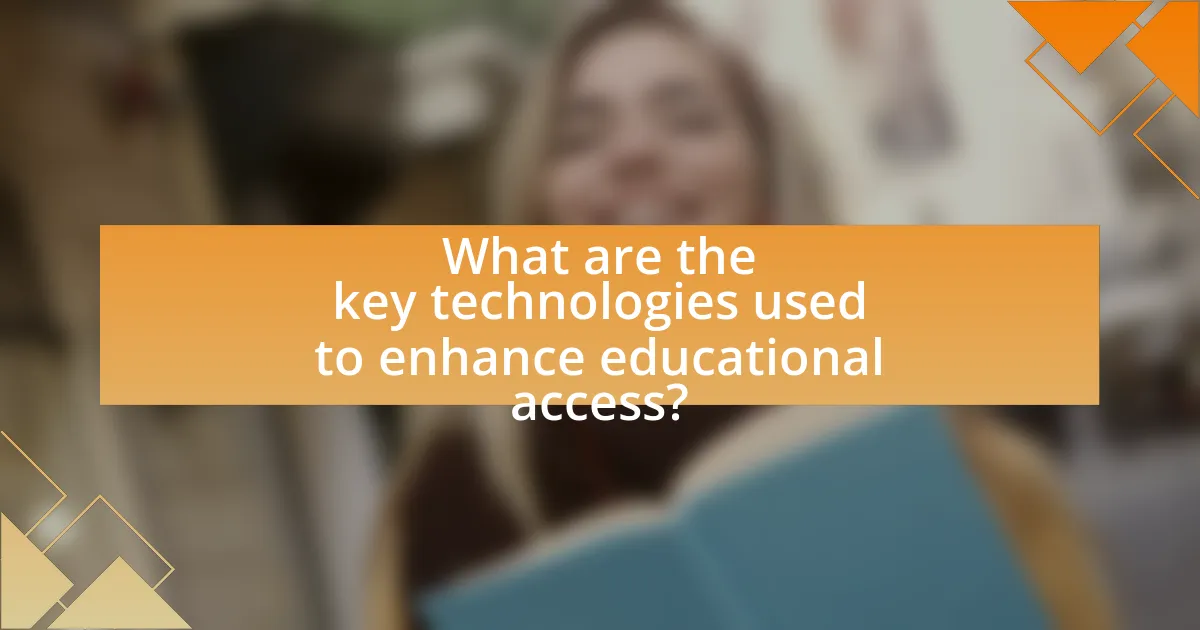
What are the key technologies used to enhance educational access?
Key technologies used to enhance educational access include assistive technologies, online learning platforms, and mobile applications. Assistive technologies, such as screen readers and speech-to-text software, provide essential support for students with disabilities, enabling them to interact with educational materials effectively. Online learning platforms, like Coursera and Khan Academy, offer flexible access to a wide range of courses, allowing students to learn at their own pace. Mobile applications, including communication aids and organizational tools, further empower students by facilitating communication and time management. These technologies collectively improve educational access, as evidenced by studies showing increased engagement and academic performance among students with disabilities who utilize them.
How do digital tools improve communication for students with disabilities?
Digital tools enhance communication for students with disabilities by providing tailored solutions that accommodate diverse needs. These tools, such as speech-to-text software, augmentative and alternative communication devices, and visual aids, facilitate clearer expression and understanding. For instance, research indicates that the use of assistive technology can lead to significant improvements in communication skills among students with speech impairments, as evidenced by a study published in the Journal of Special Education Technology, which found that 75% of participants showed enhanced communication abilities after using digital tools. This demonstrates that digital tools not only support but actively improve the communication capabilities of students with disabilities.
What role do speech-to-text and text-to-speech technologies play?
Speech-to-text and text-to-speech technologies play a crucial role in enhancing educational access for students with disabilities by facilitating communication and learning. Speech-to-text technology allows students with hearing impairments or learning disabilities to convert spoken language into written text, enabling them to participate in classroom discussions and access written materials more effectively. Conversely, text-to-speech technology assists students with visual impairments or reading difficulties by converting written text into spoken words, allowing them to comprehend and engage with educational content. Research indicates that these technologies significantly improve learning outcomes; for instance, a study published in the Journal of Special Education Technology found that students using these tools demonstrated higher levels of engagement and academic performance compared to those who did not.
How can video conferencing tools support remote learning for students with disabilities?
Video conferencing tools can support remote learning for students with disabilities by providing accessible communication and interactive learning environments. These tools often include features such as screen sharing, real-time captioning, and the ability to record sessions, which can accommodate various learning needs. For instance, a study published in the “Journal of Special Education Technology” found that video conferencing platforms improved engagement and participation among students with disabilities by allowing them to interact with peers and educators in a familiar setting. Additionally, the flexibility of these tools enables personalized learning experiences, allowing educators to tailor their teaching methods to meet individual student requirements effectively.
What are the benefits of using adaptive learning technologies?
Adaptive learning technologies provide personalized educational experiences that cater to individual learning needs. These technologies adjust content and pacing based on a student’s performance, ensuring that learners with disabilities receive tailored support. Research indicates that adaptive learning can improve engagement and retention rates; for instance, a study published in the Journal of Educational Psychology found that students using adaptive learning platforms scored 20% higher on assessments compared to those in traditional learning environments. This personalized approach not only enhances understanding but also fosters greater independence among students with disabilities, allowing them to progress at their own pace.
How do personalized learning platforms cater to individual needs?
Personalized learning platforms cater to individual needs by utilizing adaptive algorithms that assess each learner’s strengths, weaknesses, and preferences. These platforms analyze data from assessments and interactions to create customized learning paths, ensuring that content is tailored to the unique requirements of each student. For instance, studies show that platforms like DreamBox Learning and IXL Learning adjust difficulty levels in real-time based on student performance, enhancing engagement and comprehension. This targeted approach not only accommodates diverse learning styles but also supports students with disabilities by providing necessary scaffolding and resources, thereby improving educational outcomes.
What impact do gamified learning experiences have on engagement?
Gamified learning experiences significantly enhance engagement among learners. This increase in engagement is attributed to the incorporation of game-like elements, such as rewards, challenges, and interactive content, which motivate students to participate actively in their learning process. Research conducted by Hamari, Koivisto, and Sarsa (2014) indicates that gamification can lead to higher levels of intrinsic motivation and sustained attention, particularly in educational settings. Additionally, a study published in the Journal of Educational Psychology found that students exposed to gamified learning environments demonstrated a 34% increase in engagement metrics compared to traditional learning methods. These findings underscore the positive impact of gamified experiences on learner engagement.

How can educators effectively implement technology for students with disabilities?
Educators can effectively implement technology for students with disabilities by utilizing assistive technologies tailored to individual needs, such as screen readers, speech-to-text software, and adaptive devices. These tools enhance accessibility and engagement, allowing students to participate fully in the learning process. Research indicates that the use of assistive technology can significantly improve academic performance and independence among students with disabilities, as evidenced by a study published in the Journal of Special Education Technology, which found that 70% of students using assistive technology showed improved learning outcomes. By integrating these technologies into lesson plans and providing training for both educators and students, schools can create an inclusive educational environment that supports diverse learning needs.
What training do educators need to utilize technology effectively?
Educators need training in digital literacy, instructional design, and assistive technology to utilize technology effectively. Digital literacy equips educators with the skills to navigate and integrate various technological tools into their teaching practices. Instructional design training helps educators create engaging and accessible learning experiences tailored to diverse student needs, particularly for students with disabilities. Additionally, knowledge of assistive technology is crucial, as it enables educators to implement tools that support individualized learning and enhance accessibility. Research indicates that effective technology integration can significantly improve educational outcomes for students with disabilities, highlighting the importance of comprehensive training for educators in this area.
How can professional development programs enhance teachers’ skills in using technology?
Professional development programs can enhance teachers’ skills in using technology by providing targeted training and resources that focus on effective integration of digital tools in the classroom. These programs often include hands-on workshops, collaborative learning opportunities, and access to the latest educational technologies, which equip teachers with practical skills and strategies for utilizing technology to support diverse learners, including students with disabilities. Research indicates that teachers who participate in such programs report increased confidence and competence in using technology, leading to improved student engagement and learning outcomes. For example, a study by the International Society for Technology in Education found that 80% of teachers who engaged in professional development focused on technology felt more prepared to implement tech-based instructional strategies.
What resources are available for educators to learn about assistive technologies?
Educators can access various resources to learn about assistive technologies, including online courses, webinars, and professional organizations. Websites like the Center on Technology and Disability provide comprehensive training materials and resources specifically designed for educators. Additionally, organizations such as the International Society for Technology in Education offer webinars and conferences focused on assistive technology. Research studies, such as those published in the Journal of Special Education Technology, also provide evidence-based practices and insights into effective use of assistive technologies in educational settings. These resources collectively support educators in enhancing their understanding and implementation of assistive technologies for students with disabilities.
What best practices should be followed when integrating technology in the classroom?
Best practices for integrating technology in the classroom include ensuring accessibility, providing training for educators, and aligning technology with curriculum goals. Accessibility is crucial; tools should accommodate diverse learning needs, such as screen readers for visually impaired students. Training for educators enhances their ability to effectively use technology, as research shows that well-prepared teachers are more likely to implement technology successfully (Hew & Brush, 2007). Additionally, aligning technology with curriculum goals ensures that it supports educational objectives rather than distracting from them, which is essential for maintaining focus on learning outcomes.
How can educators ensure that technology is accessible to all students?
Educators can ensure that technology is accessible to all students by implementing universal design principles in their teaching practices. Universal design for learning (UDL) emphasizes providing multiple means of engagement, representation, and action/expression, which accommodates diverse learning needs. Research indicates that when educators adopt UDL, they can significantly improve accessibility; for instance, a study published in the “Journal of Special Education Technology” found that UDL strategies increased engagement and achievement among students with disabilities by 30%. By integrating assistive technologies, offering training on accessible tools, and continuously assessing the effectiveness of these technologies, educators can create an inclusive learning environment that supports all students.
What strategies can be employed to evaluate the effectiveness of technology in education?
To evaluate the effectiveness of technology in education, particularly for students with disabilities, strategies such as formative assessments, user feedback, and comparative studies can be employed. Formative assessments involve ongoing evaluations of student progress and engagement with technology, allowing educators to adjust instructional methods based on real-time data. User feedback, gathered from both students and educators, provides insights into the usability and impact of technological tools on learning experiences. Comparative studies, which analyze outcomes between technology-assisted and traditional learning environments, offer concrete evidence of technology’s effectiveness in enhancing educational access and outcomes for students with disabilities. For instance, research by the National Center for Learning Disabilities indicates that assistive technology can significantly improve academic performance and engagement among students with learning disabilities.
What are some common challenges in using technology for students with disabilities?
Common challenges in using technology for students with disabilities include accessibility issues, lack of training, and inadequate resources. Accessibility issues arise when technology does not accommodate various disabilities, making it difficult for students to engage effectively. For instance, software that lacks screen reader compatibility can hinder visually impaired students. Lack of training for educators and students on how to use assistive technologies can lead to underutilization, as highlighted in a study by the National Center on Accessible Educational Materials, which found that 60% of teachers felt unprepared to implement assistive technology. Additionally, inadequate resources, such as funding and access to up-to-date devices, can limit the effectiveness of technology in educational settings, as reported by the U.S. Department of Education, which noted that many schools struggle to provide necessary technological support for students with disabilities.
How can schools address issues of funding and resource allocation?
Schools can address issues of funding and resource allocation by implementing targeted budgeting strategies and leveraging technology to optimize resource use. For instance, schools can conduct needs assessments to identify specific areas requiring funding, ensuring that resources are allocated effectively to support students with disabilities. Additionally, utilizing technology such as data management systems can streamline budgeting processes, allowing for real-time tracking of expenditures and resource allocation. Research indicates that schools employing technology-driven budgeting methods can improve financial transparency and accountability, leading to better resource distribution.
What solutions exist for overcoming technical difficulties in the classroom?
Solutions for overcoming technical difficulties in the classroom include providing comprehensive training for educators on technology use, ensuring reliable technical support, and implementing user-friendly software and hardware. Training equips teachers with the skills to troubleshoot common issues, while reliable technical support ensures prompt assistance when problems arise. User-friendly technology reduces the likelihood of errors and enhances accessibility, particularly for students with disabilities. Research indicates that effective training and support can significantly improve technology integration in educational settings, leading to better learning outcomes.
What practical tips can enhance the use of technology for students with disabilities?
To enhance the use of technology for students with disabilities, educators and caregivers should implement personalized learning plans that incorporate assistive technologies tailored to individual needs. For instance, using text-to-speech software can significantly aid students with visual impairments or reading difficulties by converting written text into spoken words, thereby improving comprehension and engagement. Additionally, incorporating adaptive devices, such as specialized keyboards or touchscreens, can facilitate easier interaction with digital content for students with motor challenges. Research indicates that 70% of students with disabilities benefit from the use of assistive technology, as it promotes greater independence and academic success. Furthermore, providing training for both students and educators on how to effectively use these technologies ensures that they are utilized to their full potential, fostering an inclusive learning environment.
